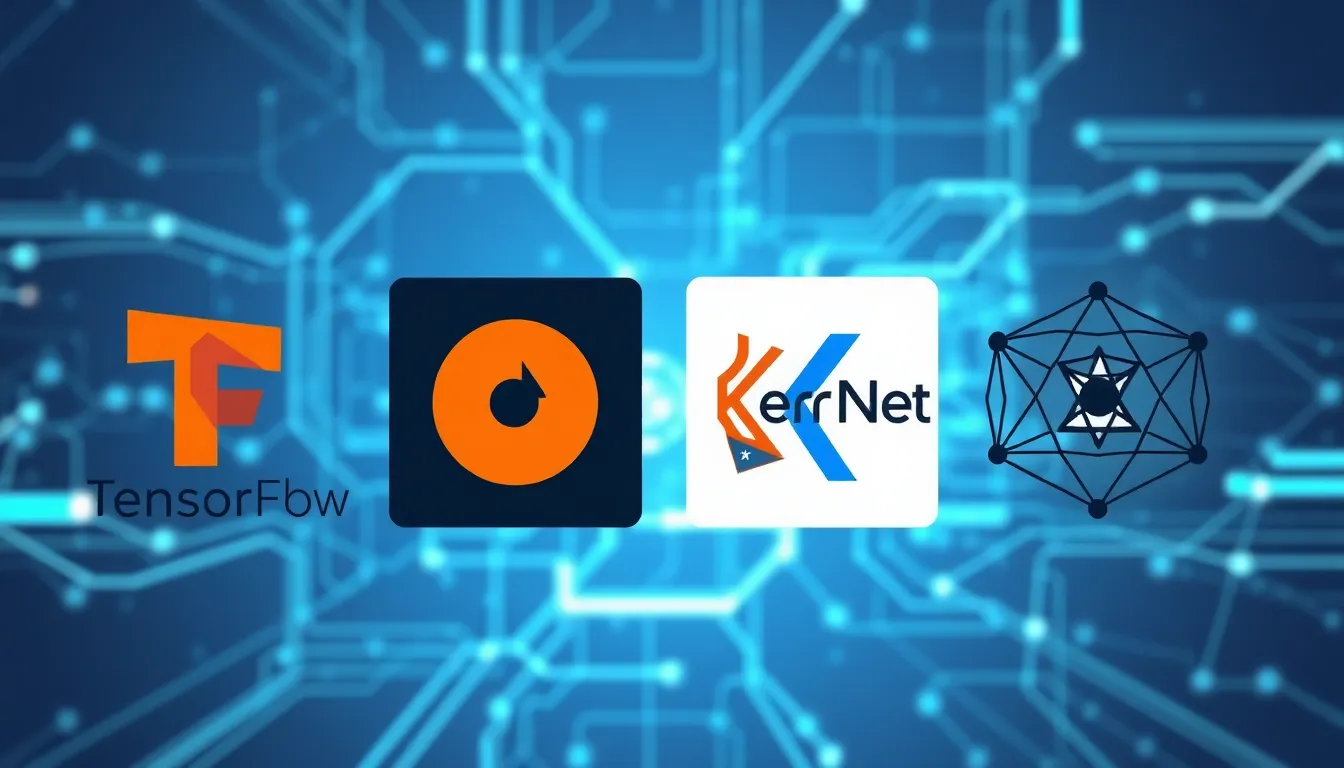In the rapidly evolving world of artificial intelligence, frameworks play a crucial role in shaping how developers build and deploy intelligent systems. These frameworks provide the essential tools and libraries that streamline the development process, making it easier to create robust AI applications. From machine learning to natural language processing, the right framework can significantly enhance productivity and innovation.
As businesses increasingly rely on AI technologies, understanding different frameworks becomes vital. Each framework offers unique features and capabilities, catering to various needs and skill levels. By exploring popular AI frameworks, developers can make informed choices that align with their project goals and technical requirements. This article delves into the landscape of AI frameworks, highlighting their significance and offering insights into selecting the best one for specific applications.
Table of Contents
ToggleOverview of AI Frameworks
AI frameworks serve as foundational tools that streamline the development of artificial intelligence applications. They provide libraries, APIs, and pre-built components which expedite everything from model training to deployment. These frameworks cater to different aspects of AI, such as machine learning, deep learning, and natural language processing.
Popular AI Frameworks
- TensorFlow: Developed by Google, TensorFlow supports a wide range of tasks, including neural network training, and provides flexibility through its high-level APIs.
- PyTorch: Created by Facebook AI Research, PyTorch is known for its dynamic computation graph, making it ideal for research-oriented environments.
- Keras: Keras simplifies model design with easy access to different neural network layers. It integrates seamlessly with TensorFlow, enhancing usability for developers.
- Scikit-learn: This framework focuses on traditional machine learning algorithms. It offers tools for data preprocessing, model evaluation, and feature selection, catering to users who prioritize simplicity.
- Apache MXNet: Recognized for its scalability, MXNet supports distributed training and deployment, making it suitable for large-scale applications.
Key Features of AI Frameworks
- Modularity: AI frameworks typically allow developers to build applications from components, enhancing flexibility and customization.
- Community Support: Leading frameworks benefit from large communities that contribute resources, libraries, and troubleshooting support, aiding developers in implementation.
- Documentation: Comprehensive documentation ensures that users can quickly learn and utilize frameworks effectively, reducing the learning curve.
Choosing the Right Framework
Selecting an appropriate AI framework depends on project requirements. Considerations include:
- Ease of Use: Some frameworks offer a steeper learning curve than others. Beginners may prefer those with intuitive interfaces.
- Performance: Certain frameworks excel in speed and efficiency, particularly for large datasets or complex models.
- Compatibility: Frameworks might integrate better with specific programming languages or existing tools, influencing selection for developers.
Understanding the landscape of AI frameworks enables developers to make informed decisions, optimizing their development processes and enhancing project outcomes.
Popular AI Frameworks

The landscape of AI frameworks features several options, each with distinct advantages and usage scenarios. Below are some of the most widely adopted frameworks in the industry.
TensorFlow
TensorFlow, developed by Google Brain, serves as a versatile framework for building machine learning models. It features a comprehensive ecosystem that includes tools like TensorBoard for visualization and TensorFlow Extended (TFX) for production workflows. TensorFlow’s strong community support, extensive documentation, and compatibility with large-scale data processing make it ideal for both research and production environments. Its efficiency in deploying models across various platforms adds to its popularity among developers.
PyTorch
PyTorch, created by Facebook’s AI Research lab, emphasizes usability and flexibility. It provides dynamic computation graphs, allowing developers to modify network behavior on-the-fly. This feature proves helpful for tasks that require experimentation and rapid iteration. PyTorch’s intuitive interface, combined with robust libraries like TorchVision for computer vision tasks, makes it a favorite among researchers and academics. Additionally, PyTorch’s compatibility with ONNX facilitates model deployment in different environments.
Keras
Keras serves as a high-level API for building and training deep learning models, functioning as an interface for TensorFlow. It simplifies the process of selecting and configuring models with clear, concise syntax. Keras supports various backends, allowing developers to switch frameworks cheaply. Its focus on user-friendliness and rapid prototyping makes it an excellent choice for beginners and those looking to streamline their development workflows. The inclusion of pre-trained models accelerates project implementation.
Apache MXNet
Apache MXNet, known for its scalability and efficiency, supports both symbolic and imperative programming. It excels in training deep learning models on cloud platforms, making it suitable for large-scale applications. The framework’s modular design allows developers to customize components easily. MXNet also provides seamless integration with AWS, enhancing its appeal for cloud-based AI solutions. Furthermore, MXNet’s support for multiple programming languages expands accessibility across diverse developer backgrounds.
Key Features of AI Frameworks
AI frameworks offer essential attributes that enhance the development and deployment of artificial intelligence applications. Understanding these key features helps developers select the most suitable framework for their projects.
Scalability
Scalability refers to the ability of a framework to handle increased workloads efficiently. Frameworks like TensorFlow and Apache MXNet excel in scaling across multiple GPUs and cloud environments, facilitating the deployment of large AI models. Users can leverage distributed training capabilities, enabling organizations to manage resource demands as projects grow. Elastic scalability supports businesses in adapting to changing workloads without compromising performance.
Flexibility
Flexibility represents the ease with which developers can experiment and modify existing models. PyTorch stands out in this area, allowing for dynamic computation graphs that provide real-time feedback during model training. This approach simplifies the experimentation process, making it ideal for researchers. Keras also enhances flexibility by enabling developers to switch backends seamlessly while maintaining a user-friendly interface, fostering rapid prototyping and modification of AI models.
Community Support
Community support is vital for the ongoing development and troubleshooting of AI frameworks. Popular frameworks like TensorFlow and PyTorch benefit from robust, active communities, offering extensive resources, tutorials, and forums for developers. This support accelerates the learning curve and aids in problem resolution. Access to a wealth of knowledge fosters collaboration, encouraging input from diverse contributors, which ultimately enhances the framework’s capabilities and innovative potential.
Choosing the Right AI Framework
Selecting the appropriate AI framework hinges on several pivotal factors. Developers must carefully evaluate their project requirements and the overall usability of the selected framework.
Project Requirements
Project requirements play a crucial role in framework selection. Specific factors to assess include:
- Type of Task: Different frameworks excel in various tasks, such as computer vision, natural language processing, or general machine learning. For instance, TensorFlow shines in large-scale deployments, while PyTorch is often preferred for research-oriented tasks.
- Development Timeline: Analyze deadlines. Rapid prototyping may favor frameworks like Keras, while long-term projects might benefit from the robustness of TensorFlow.
- Scalability Needs: Determine if the project requires scaling. Frameworks like Apache MXNet effectively manage significant workloads, making them suitable for large-scale applications.
Ease of Use
- Learning Curve: Frameworks like Keras offer simplicity, making them ideal for beginners. More complex options, like TensorFlow, may involve longer onboarding times.
- Documentation Quality: Comprehensive documentation facilitates efficient learning and problem-solving. Frameworks with extensive resources, like TensorFlow and PyTorch, provide robust support for developers.
- Community Support: A strong community enhances usability. Active communities around TensorFlow and PyTorch offer forums, tutorials, and resources, promoting smoother development experiences.
AI frameworks play a pivotal role in the development landscape of artificial intelligence. By offering essential tools and libraries, they empower developers to create innovative applications efficiently. Understanding the strengths and unique features of each framework enables developers to choose the right one for their specific needs.
As the demand for AI solutions grows, the ability to navigate these frameworks becomes increasingly important. With considerations like scalability, flexibility, and community support, developers are better equipped to optimize their projects. Embracing the right framework not only streamlines the development process but also enhances overall project success in the ever-evolving AI landscape.




